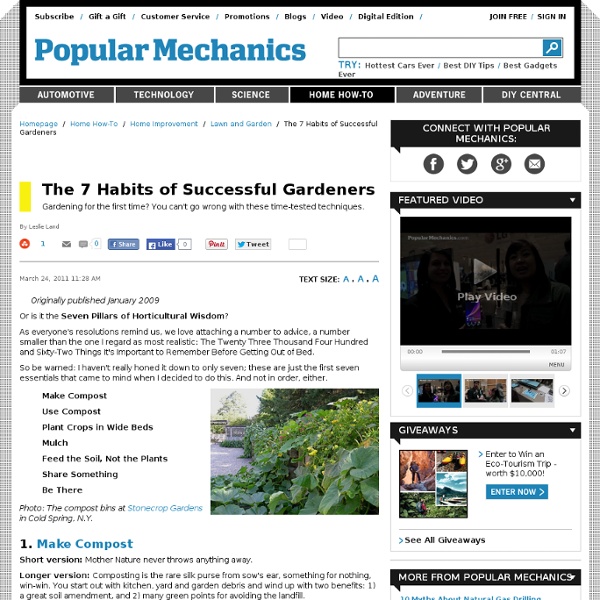Garden Water Filters - Outdoor or Indoor Use
Why should I remove chlorine from my garden? Chlorine is designed to kill living organisms such as fungi and bacteria that can contaminate your water source. It does such a great job of killing these organisms that it can be harmful to your plants, because your plants rely on some of the fungi and bacteria to survive. Every plant's survival is based on the nutrients it receives from its water and soil.
Potatoes
What are we doing in the garden right now? A whole lot of stuff, but let's consider the humble potato. We only grow fingerling types for Manresa. They are tastier and more useful for the chef. We can start harvesting them earlier than standard-type potatoes as well. I buy my seed potatoes from Ronniger's in Colorado.
Care and Cultivation of Permanent Garden Beds - Organic Gardening
One of the basic tenets of organic gardening is to put as much effort into improving soil fertility as you put into growing your crops. When you use permanent garden beds and pathways, you can concentrate on building soil in deeply worked beds that will improve over a period of years, all the while growing robust, disease-resistant vegetables. Permanent vegetable beds also make more efficient use of water and fertilizer, and soil compaction is limited to pathways where repeated footsteps can naturally inhibit the growth of weeds. In the 2008 article Gardening for Keeps, I addressed the practical aspects of designing a garden using permanent beds, pathways and green access corridors (which also produce nutrient-rich grass clippings). In this article, I will cover some benefits of permanent garden beds, plus discuss the invisible soil food web and how you can conserve and enrich the life-forms that create superior soil fertility.
Square Foot Gardening 101
Update! Check out our new Square Foot Gardening Infographic for even more tips, diagrams, a plant list and much more. I recently stumbled upon a book (All New Square Foot Gardening: Grow More in Less Space! by Mel Bartholomew) with an interesting gardening method called square foot gardening, and decided we would give it a try.
Grow 100 lbs. Of Potatoes In 4 Square Feet: {How To
Quite the clever gardening tip here folks! Today’s feature includes tips from three different sources for growing potatoes vertically (in layers) instead of spread out in rows across your garden. If you have limited garden space or want to try some nifty gardening magic, this could be a great option for you. First, there’s this article from The Seattle Times: It’s Not Idaho, But You Still Can Grow Potatoes:
Flash in the Pan
I haven't purchased garlic since 1996. That's because I grow enough to eat a bulb of garlic every day, year-round. While most of my garden adventures are hobby-level attempts at self-sufficiency, my garlic crop is for real. Garlic is an overwintering crop, planted in fall and harvested mid-summer. So if you want to have a crop next year, it's time to think about planting.
Start a Quick and Easy Food Garden
If your yard has at least a 20-by-28-foot space that gets full or almost full sun, you can grow enough vegetables to have fresh food all season with surprisingly little effort. Go ahead and dig beds if you’re lucky enough to have naturally fertile, well-drained soil, but don’t let soil flaws stop you from starting a food garden. Instead, use this quick and simple bag gardening technique.
27 Medicinal Plants Worth Your Garden Space
Playful as kids are, accidents happen. And the accident that befallen me at 7 years old was the feeling of the hot exhaust pipe of a motorcycle kissing the skin of my leg. Grandma was around and saw it.
Aquaponics 4 You - Step-By-Step How To Build Your Own Aquaponics System
“Break-Through Organic Gardening Secret Grows You Up To 10 Times The Plants, In Half The Time, With Healthier Plants, While the "Fish" Do All the Work...” Imagine a Garden Where There's No More Weeds or Soil Pests, No Tilling or Cultivating, No Fertilizer Spreading or Compost Shredding, No Manure Spreading or Irrigating, and No Tractor Shed Required... And Yet... Your Plants Grow Abundantly, Taste Amazing, and Are Extremely Healthy. Here's How It Works: WARNING: What You're About To Read Is Life Changing Information, DO NOT Read This If You Don't Want To Discover a Way To Grow Up to TEN Times the Amount Of Organic Produce In the Same Area of Ground, Use 70% Less Energy, And Absolutely Revolutionize Your Gardening and Farming Forever.
How to Grow Delectable Lemon Basils
January 28th, 2009 1Email 17 users recommend 'Mrs. Burns' is a large, strongly scented lemon basil.



